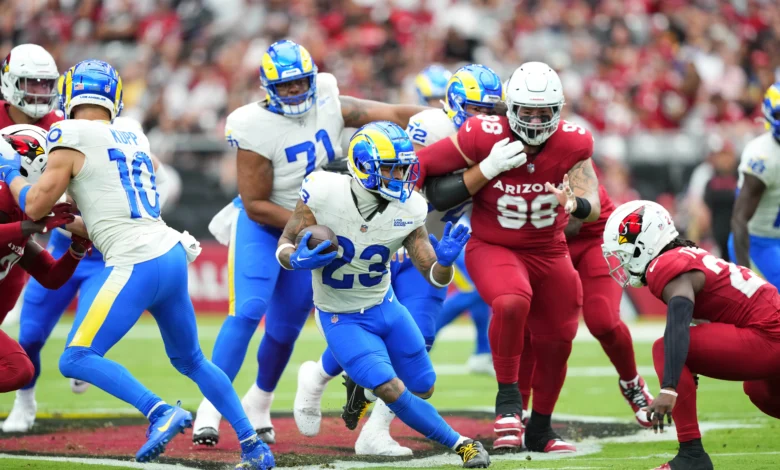Los Angeles Rams vs Arizona Cardinals Match Player Stats: A Deep Dive into a Classic Rivalry

The National Football League (NFL) is built on rivalries, and one of the more intriguing battles in the NFC West division is the showdown between the Los Angeles Rams and the Arizona Cardinals. While not as hyped as some older rivalries, the Rams–Cardinals clash has given fans countless memorable moments, thrilling finishes, and standout player performances. To fully understand this rivalry, we must explore not only the history but also the statistical battles that highlight individual brilliance and team strategies. This article offers an in-depth 2000-word breakdown of the Rams vs Cardinals rivalry with a strong focus on match player stats, analyzing both historical patterns and recent encounters.
Historical Background of the Rivalry
The Rams and Cardinals first played against each other in 1937. Over the decades, both franchises have relocated and reinvented themselves: the Rams from Cleveland to Los Angeles, then to St. Louis, and back to Los Angeles; the Cardinals from Chicago to St. Louis to Phoenix, and eventually Arizona. Despite these geographical shifts, their head-to-head series has maintained a steady competitive edge.
Historically, the Rams hold the lead in the all-time series. Their dominance has been particularly noticeable in the 2000s and 2010s, although Arizona has managed to secure memorable victories when their roster talent peaked. This head-to-head trend shows that while the Rams may have the overall edge, the Cardinals have consistently produced players capable of game-changing performances.
Recent Matchups: Rams vs Cardinals
Week 2, 2024 Season – Cardinals 41, Rams 14
One of the most eye-catching recent clashes was in September 2024, when the Arizona Cardinals crushed the Los Angeles Rams 41–14. This game served as a reminder that statistics and player execution can completely reshape a rivalry narrative.
Key Player Stats from that Game:
Kyler Murray (QB, Cardinals): Efficient and explosive, Murray completed 17 of 21 passes for 266 yards and 3 touchdowns. His quick release and mobility kept the Rams defense guessing.
Marvin Harrison Jr. (WR, Cardinals, rookie): In only his second NFL game, Harrison Jr. announced himself to the league with 2 touchdowns on 4 receptions, including a spectacular 60-yard catch-and-run that electrified the Arizona crowd.
James Conner (RB, Cardinals): Conner dominated on the ground with 122 rushing yards on 21 carries, averaging nearly 6 yards per attempt. His physical style wore down the Rams’ defensive front.
Matthew Stafford (QB, Rams): The veteran quarterback threw for 216 yards but struggled under pressure and failed to generate consistent drives.
Cooper Kupp (WR, Rams): Injured early in the game, Kupp’s absence left the Rams passing attack one-dimensional, forcing Stafford to lean heavily on Puka Nacua.
Arizona Defense: The Cardinals recorded 3 sacks and forced multiple three-and-outs, shutting down any chance of a Rams comeback.
The box score revealed dominance across the board: Arizona racked up 489 total yards compared to just 245 for Los Angeles. In every phase—passing, rushing, and defense—the Cardinals were the superior team.
Week 17, 2024 Season – Rams 13, Cardinals 9
Later in the same season, the Rams got revenge in a much tighter contest. Unlike the high-scoring affair earlier in the year, this matchup was a defensive battle.
Key Player Stats from that Game:
Kyler Murray (QB, Cardinals): Threw for 321 yards on 33 completions out of 48 attempts, with 1 touchdown. His stat line reflected control of the passing game, but turnovers and stalled red-zone drives cost Arizona points.
Trey McBride (TE, Cardinals): Delivered a monster game with 12 receptions for 123 yards and a touchdown. His ability to exploit mismatches against Rams linebackers kept Arizona’s offense alive.
Arizona Rushing Attack: The Cardinals accumulated 113 yards on the ground, averaging 5.1 yards per carry. Despite their effectiveness, they could not convert rushing efficiency into touchdowns.
Kyren Williams (RB, Rams): The Rams’ offensive spark, with 56 yards rushing and the team’s lone touchdown. His ability to grind out tough yards made the difference in a low-scoring game.
Puka Nacua (WR, Rams): Continued his breakout campaign with 10 receptions for 129 yards, keeping the Cardinals secondary under pressure throughout the game.
Ahkello Witherspoon (CB, Rams): Provided the game-sealing interception in the final minutes, showcasing the Rams defense’s ability to make clutch plays.
Though Arizona gained 396 yards compared to the Rams’ 257, the turnover battle determined the outcome. The Cardinals committed 2 turnovers, while the Rams played a clean game. Witherspoon’s interception in crunch time highlighted the old adage: defense wins games.
Statistical Themes in the Rivalry
By comparing these recent matchups and looking at long-term trends, several themes emerge that define Rams vs Cardinals games:
1. Quarterback Battles
Kyler Murray is Arizona’s centerpiece, and his ability to extend plays and hit deep targets like Marvin Harrison Jr. or Trey McBride makes the Cardinals dangerous.
Matthew Stafford, despite being a Super Bowl–winning quarterback, sometimes struggles against Arizona’s pressure when the Rams’ run game falters.
2. Wide Receiver Playmakers
Arizona’s rise of Marvin Harrison Jr. paired with the consistency of McBride has made them one of the most exciting young receiving duos in the league.
For the Rams, Cooper Kupp (when healthy) and Puka Nacua form a deadly tandem, combining veteran route precision with youthful explosiveness.
3. Running Game Impact
When James Conner dominates on the ground, Arizona often controls the tempo and clock.
Conversely, the Rams rely heavily on Kyren Williams, and his productivity usually correlates with their success.
4. Defensive X-Factors
Arizona’s defense has shown flashes of dominance, especially in 2024’s Week 2 blowout, when they forced Stafford into hurried throws.
The Rams defense, anchored by stars like Aaron Donald in recent years, remains capable of game-sealing plays—as seen in Witherspoon’s interception.
5. Turnover Battle
Turnovers repeatedly swing outcomes. Even when Arizona racks up more yards, giveaways have doomed them. Clean football from the Rams often compensates for yardage disadvantages.
Deeper Player Analysis
Kyler Murray
Murray’s stats against the Rams reflect both brilliance and frustration. His passing yards frequently exceed 250, and his dual-threat ability makes him a nightmare. However, mistakes in crucial red-zone moments sometimes prevent Arizona from capitalizing on his yardage.
Marvin Harrison Jr.
In just one season, Harrison Jr. has emerged as the Cardinals’ X-factor. His ability to stretch defenses vertically is already evident. Future Rams vs Cardinals games will likely hinge on how L.A. schemes against him—whether with double coverage or deep safety help.
Trey McBride
McBride is redefining the tight end role for Arizona. His December 2024 stat line of 12 catches for 123 yards showed he can dominate when given targets. He creates mismatches and provides Murray with a reliable security blanket.
Matthew Stafford
Stafford remains a steady hand for the Rams, but without his full complement of weapons, his effectiveness drops. His arm talent is still elite, but age and pressure from defensive fronts mean the Rams must support him with balance.
Puka Nacua
Perhaps the biggest surprise in recent years, Nacua has quickly become one of the Rams’ most reliable receivers. His 129-yard game in December 2024 proves he is not a fluke—he thrives on volume targets and precise routes.
Kyren Williams
Williams isn’t the flashiest running back, but his consistency and ability to pick up tough yards make him vital for the Rams. His role as a red-zone finisher adds an edge to the offense.
The Tactical Chess Match
Every Rams vs Cardinals game is shaped by the clash of strategies:
Arizona’s Offensive Approach: Spread formations, play-action, and deep shots to Harrison Jr. or McBride. Murray’s mobility creates extra time for plays to develop.
Rams’ Counter: Mix of zone coverage and disguised blitzes to disrupt Murray’s rhythm, while offensively leaning on ball control through Williams and high-percentage throws to Nacua or Kupp.
Key Variable: Who wins the trenches? If the Rams’ pass rush collapses the pocket, Murray struggles. If Arizona’s line holds, explosive plays follow.
Looking Ahead
Future Rams vs Cardinals clashes promise excitement. Arizona’s youthful offensive weapons, paired with Murray’s leadership, suggest they are building toward sustained competitiveness. Meanwhile, the Rams remain dangerous thanks to Stafford’s experience, their skilled receivers, and a defense that can make pivotal plays.
The rivalry may not have the same historical prestige as Packers–Bears or Cowboys–49ers, but its balance of offensive fireworks and defensive grit makes it one of the most entertaining in the NFC West.
Conclusion
The Los Angeles Rams vs Arizona Cardinals rivalry is far more than just another divisional matchup. It represents a constant struggle for supremacy between two franchises that have faced relocations, rebuilds, and resurgences. By diving into the player stats of recent games, we see how individual brilliance—whether Murray’s passing, Harrison Jr.’s explosiveness, McBride’s reliability, Nacua’s consistency, or Witherspoon’s clutch defense—shapes outcomes.
While the Rams have historically led the series, the Cardinals are closing the gap with a new wave of talent. As stats reveal, yardage alone does not guarantee victory; turnovers, situational execution, and defensive playmaking often decide who walks away with bragging rights.
Every time the Rams and Cardinals meet, fans can expect not just a game, but a chess match full of star power, strategy, and unforgettable performances. And with rising stars on both sides, the rivalry’s next chapters promise even more compelling player stats for NFL enthusiasts to dissect.



